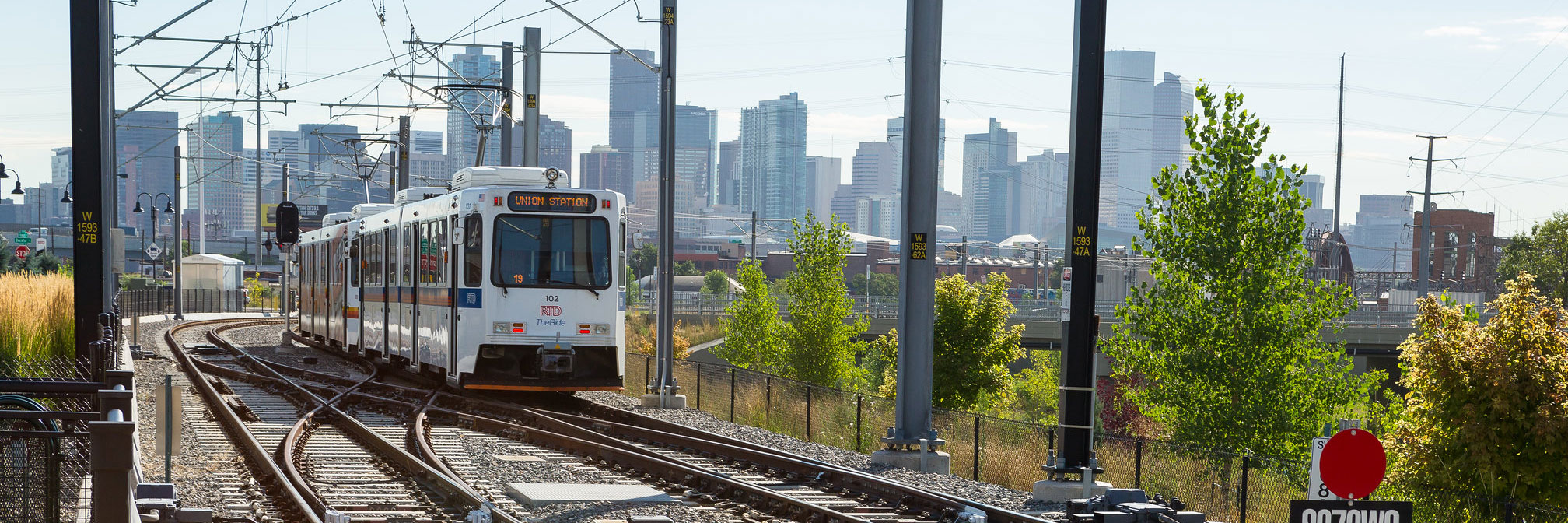
Finishing FasTracks
2025 ReportON THIS PAGE
- Download a copy of the draft 2025 Finishing FasTracks Report
- Learn more about the four unfinished rail corridors
- See an overview of the corridor costs, funding strategies, and potential sources of additional revenue
- Provide feedback and ask questions about the draft report
FasTracks is a voter-approved, multi-billion-dollar transit expansion program launched in 2004 to improve mobility across the Denver metro area. Led by RTD, FasTracks set out to build more than 120 miles of new commuter rail and light rail, nearly 20 miles of bus rapid transit, and dozens of new transit hubs and park-n-rides. Over the last 20 years, FasTracks has delivered several high-profile extension projects and connections.
While FasTracks has significantly expanded transit access and reshaped regional connectivity, it has also faced challenges with funding shortfalls, cost escalations, and delayed timelines, leaving some corridors waiting for completion.
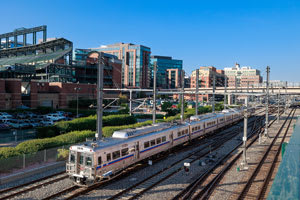
Finishing FasTracks
Senate Bill 24-230, titled “Concerning Support for Statewide Remediation Services that Positively Impact the Environment,” (SB-230) required, among other things, RTD to prioritize the completion of the Northwest Rail (B Line) and the North Metro (N Line) corridors of the 2004 voter-approved FasTracks Plan. Additionally, the legislation required RTD to submit a report to the Governor and the General Assembly by July 1, 2025, demonstrating how RTD will complete the Plan’s unfinished corridors by 2034. That legislation was amended by Senate Bill 25-161, titled “Transit Reform” (SB-161), to require RTD to include additional financial information in the report to the Governor and General Assembly while extending the report’s submittal deadline to December 1, 2025.
RTD's 2025 Finishing FasTracks Report includes the following information:
- Updated capital and operating costs to reflect inflation
- Revenue projections and fiscal capacity for the program completion
- A discussion of new challenges impacting project implementation
Executive Summary
2019 Unfinished Corridors Report
RTD’s 2019 Unfinished Corridors Report serves as the primary basis for compiling this report to the General Assembly and the governor. The 2019 Unfinished Corridors Report was completed in response to the April 2019 RTD Board Resolution No. 004, Series of 2019, which demonstrated the Board’s commitment to finish the FasTracks Plan.
2019 Unfinished Corridors ReportFinancial Constraints
An examination of RTD’s financial condition indicates that, between now and 2034, RTD expects to have only FasTracks Internal Savings Account (FISA) funds available for new construction, which would be insufficient to cover any of the remaining corridors. Furthermore, RTD’s 2026-2030 Five-Year Financial Forecast (FYFF) has not identified sufficient cash flow available for debt service if new borrowings for incremental service were to be considered.
State funding from programs authorized by SB-260, SB-230, and SB-184 could potentially contribute toward limited plan completion. An optimistic scenario would have these programs providing up to $296 million in funding between 2026 and 2034. Depending on the funding secured for capital investments, RTD will also need funding for the operations and maintenance of the corridors, which would require a significant additional stream of ongoing funding.
| Corridor | Capital Costs (millions) | Annual Operations Cost (millions) | Daily Boardings in Horizon Year (2045) |
|---|---|---|---|
| Northwest Rail Peak Service | $ 649.6 | $ 14.0 | 1,100 |
| North Metro Completion | $ 395.7 | $ 5.4 | 1,500 |
| Southwest Extension | $ 343.5 | $ 2.5 | 700 |
| Central Extension | $ 210.5 | $ 0.7 | 300 |
| TOTAL | $ 1,599.3 | $ 22.6 | 3,600 |
Potential Funding Sources
Completing the remaining FasTracks corridors requires $1.6 billion for construction. As the table shows, RTD has identified only $441 million in potential funding for the period from 2026 to 2034, leaving a significant gap of $1.2 billion.
- (A) ProposedFive-Year Financial Forecast 2030 balance.
- (B) Total Rail Program estimate, not all of which will be dedicated to FasTracks.
- (C) For illustrative purposes, 20% of expected total funding is shown. Distribution methodology has not been established, but the broad eligibility for multimodal projects statewide means this is likely a greater allocation to FasTracks than is realistic.
- (D) Actual funding needs will be higher based on inflation.
| Funding Source | Funding Available (2026 to 2034) |
|---|---|
| FISA | $ 145 million (A) |
| SB-230 Rail Program | $ 124 million (B) |
| SB-184 | $ 162 million (C) |
| SB-260 | $ 10 million |
| TOTAL | $ 441 |
| FasTracks Construction Cost | $ 1.6 billion (D) |
| Remaining Funding Gap (Capital Cost Only) | $ 1.159 billion |
Summary
Since 2004, RTD has achieved approximately 75% program completion. However, the program has faced significant challenges, including a reduction in anticipated sales and use tax revenues beginning in the 2008 Great Recession, and construction cost escalation, including spikes in raw materials costs, supply chain challenges and disruption to labor markets.
The financial challenge is even greater than the numbers suggest:
- The $1.6 billion construction cost is in 2024 dollars and does not account for future inflation. The actual cost to build the corridors will be much higher.
- The $441 million in available funding is an optimistic estimate. It assumes a larger share of statewide funds will be allocated to FasTracks than is likely.
Even if the project were scaled back to only complete the Northwest Rail Peak Service and the North Metro corridor, the total construction cost would be approximately $1 billion. This reduced cost still far exceeds the $441 million in projected funding. Furthermore, all these figures reflect capital construction costs only. They do not include the additional millions of dollars that would be required over this period to operate and maintain the new services once they are built.
Background
Legislative Requirement
Senate Bill 24-230, titled “Concerning Support for Statewide Remediation Services that Positively Impact the Environment,” (SB-230) required, among other things, RTD to prioritize the completion of the Northwest Rail (B Line) and the North Metro (N Line) corridors of the 2004 voter-approved FasTracks Plan. Additionally, the legislation required RTD to submit a report to the Governor and the General Assembly by July 1, 2025, demonstrating how RTD will complete the Plan’s unfinished corridors by 2034. That legislation was amended by Senate Bill 25-161, titled “Transit Reform” (SB-161), to require RTD to include additional financial information in the report to the Governor and General Assembly while extending the report’s submittal deadline to December 1, 2025.
The 2019 Unfinished Corridors Report serves as the primary basis for this report to the General Assembly and the Governor. The 2019 Unfinished Corridors Report was completed in response to the April 2019 RTD Board Resolution that demonstrated the Board’s commitment to complete the regional transit expansion detailed in the 2004 voter-approved FasTracks Plan. This 2025 report, in addition to providing background and updated cost estimates for each of the four remaining corridor projects, will also provide an update and discussion of the other unfinished components of the FasTracks Plan.
2004 FasTracks Ballot Initiative
The $4.7-billion, 2004 voter-approved FasTracks Plan and ballot language (see Appendix B) included the following general components to be completed by 2016:
Rapid Transit
- 113 miles of light rail and commuter rail
- 18 miles of Bus Rapid Transit (BRT)
- 78 total rail transit stations
Enhanced Bus/Rail Connections with Convenient Timed Transfers
- 96 total Park-n-Ride facilities
- 36,021 total parking spaces
Enhanced Bus Network
- FastConnects bus network to improve suburb-to-suburb bus travel
- New bus routes and route adjustments to provide convenient connections
- By 2025, an additional 700,000 hours of bus service annually
Transit Facilities
- Enhancements to improve passenger safety, convenience and transit use
- More security measures at stations
- More shelters and information at stations and Park-n-Rides
| Corridor | Capital Costs (millions) | Annual Operations Cost (millions) | Daily Boardings in Horizon Year (2045) |
|---|---|---|---|
| Northwest Rail Peak Service | $ 649.6 | $ 14.0 | 1,100 |
| North Metro Completion | $ 395.7 | $ 5.4 | 1,500 |
| Southwest Extension | $ 343.5 | $ 2.5 | 700 |
| Central Extension | $ 210.5 | $ 0.7 | 300 |
| TOTAL | $ 1,599.3 | $ 22.6 | 3,600 |
2004 FasTracks Rapid Transit Plan Map
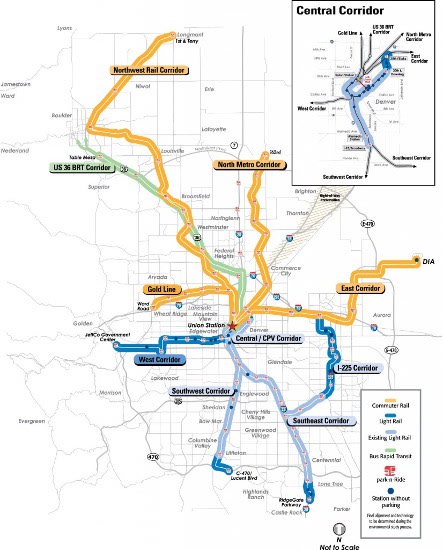
| Funding Source | Funding Available (2026 to 2034) |
|---|---|
| FISA | $ 145 million (A) |
| SB-230 Rail Program | $ 124 million (B) |
| SB-184 | $ 162 million (C) |
| SB-260 | $ 10 million |
| TOTAL | $ 441 |
| FasTracks Construction Cost | $ 1.6 billion (D) |
| Remaining Funding Gap (Capital Cost Only) | $ 1.159 billion |
DRCOG SB-208 Review
The FasTracks Plan, including the financial elements, was subject to a rigorous review from the Denver Regional Council of Governments (DRCOG) per the state-required Senate Bill 90-208 (SB-208) process, which states that “the [RTD] Board shall take no action relating to the construction of a regional fixed guideway mass transit system until such system has been approved by the designated Metropolitan Planning Organization. Each component part or corridor of such system shall be separately approved by the Metropolitan Planning Organization (MPO). Such action shall include approval of the method of financing and the technology selected for such projects.”
The following is a summary of the criteria DRCOG, as the MPO, employs in assessing fixed guideway mass transit system proposals.
- Consistency with the Adopted Metro Vision Rapid Transit Network and Regional Transportation Plan
- Technology Selection
- Projected Ridership
- Financing
- Reasonableness of cost estimates
- Cost efficiency for each system component
- Review of funding plan to ensure sufficient funds are available to construct, operate, and maintain the proposed system
- Review of available funding to ensure sufficient funds are available to maintain and expand the area-wide bus system in addition to the proposed fixed guideway system
- Review commitments if external funding is assumed
- Other
DRCOG engaged an external consultancy to assist with the SB-208 review, with a particular focus on the plan’s capital and operating cost estimates and revenue assumptions. DRCOG held public hearings on the draft report and released a final report in April 2004. The DRCOG Board adopted the report findings via resolution on April 21, 2004, thereby providing the required SB-208 approval of the plan. Among the report’s many conclusions, it found that the estimated costs per mile for the light rail corridors were within the expected range of costs to be anticipated both nationally, when comparing similar properties and alignments, and locally, when comparing the costs to RTD’s previous projects.
As a condition of approval, the DRCOG Board included a requirement for RTD to submit an annual report to DRCOG. Since 2004, RTD has prepared and submitted annual reports documenting work progress, issues facing the program, and the current financial plan. From 2004 to 2011, RTD submitted a comprehensive report with detailed updates on each FasTracks corridor, including schedule, costs, operations, issues, facilities, parking and a full, independently reviewed, financial plan.
Since 2013, the DRCOG Board has requested that in lieu of a traditional SB-208 report RTD submit a FasTracks Status Report. Those have been filed annually from 2014 to the present and include a brief update and costs spent on FasTracks projects, FasTracks Financial Plan information, and the FasTracks Map.
Plan Progress and Accomplishments
Since 2004, RTD has completed a significant portion of the FasTracks program, including 25 miles of light rail track and 53 miles of commuter rail track, implemented the Flatiron Flyer bus rapid transit service on US 36, and opened Union Station as an intermodal hub in downtown Denver.
RTD has completed the projects shown in the table below, and ridership numbers reflect average weekday boardings.
| Line | Description | Year | Opening Year Ridership | 2019 Ridership | 2024 Ridership |
|---|---|---|---|---|---|
| West Corridor: W Line | W Line (Denver Union Station to Jeffco Gov’t Center•Golden) | 2013 | 15,500 | 13,200 | 8,200 |
| US 36 Bus Rapid Transit (BRT): Flatiron Flyer | Flatiron Flyer (Boulder to Denver Union Station, Civic Center, Denver International Airport, and Anschutz campus) | 2016 | 11,600 | 12,000 | 4,400 |
| East Corridor: A Line | A Line (Denver Union Station to Denver International Airport) | 2016 | 18,200 | 23,800 | 15,400 |
| Northwest Phase I: B Line | B Line (Denver Union Station to Westminster Station) | 2016 | 1,300 | 1,600 | 400 |
| I-225: R Line | R Line (Peoria to Lincoln) | 2017 | 5,900 | 6,200 | 3,300 |
| Gold Line: G Line | G Line (Denver Union Station to Wheat Ridge•Ward Road) | 2019 | 6,100 | 6,100 | 3,000 |
| Southeast Extension: E Line | Portion of E Line (Lincoln Station to RidgeGate Parkway) | 2020 | 4,400 | 4,900 | 1,000 |
| North Metro: N Line | N Line (Denver Union Station to Eastlake•124th) | 2020 | 1,700 | Opened in 2020 | 3,600 |
Completed and Unfinished FasTracks Corridors Map
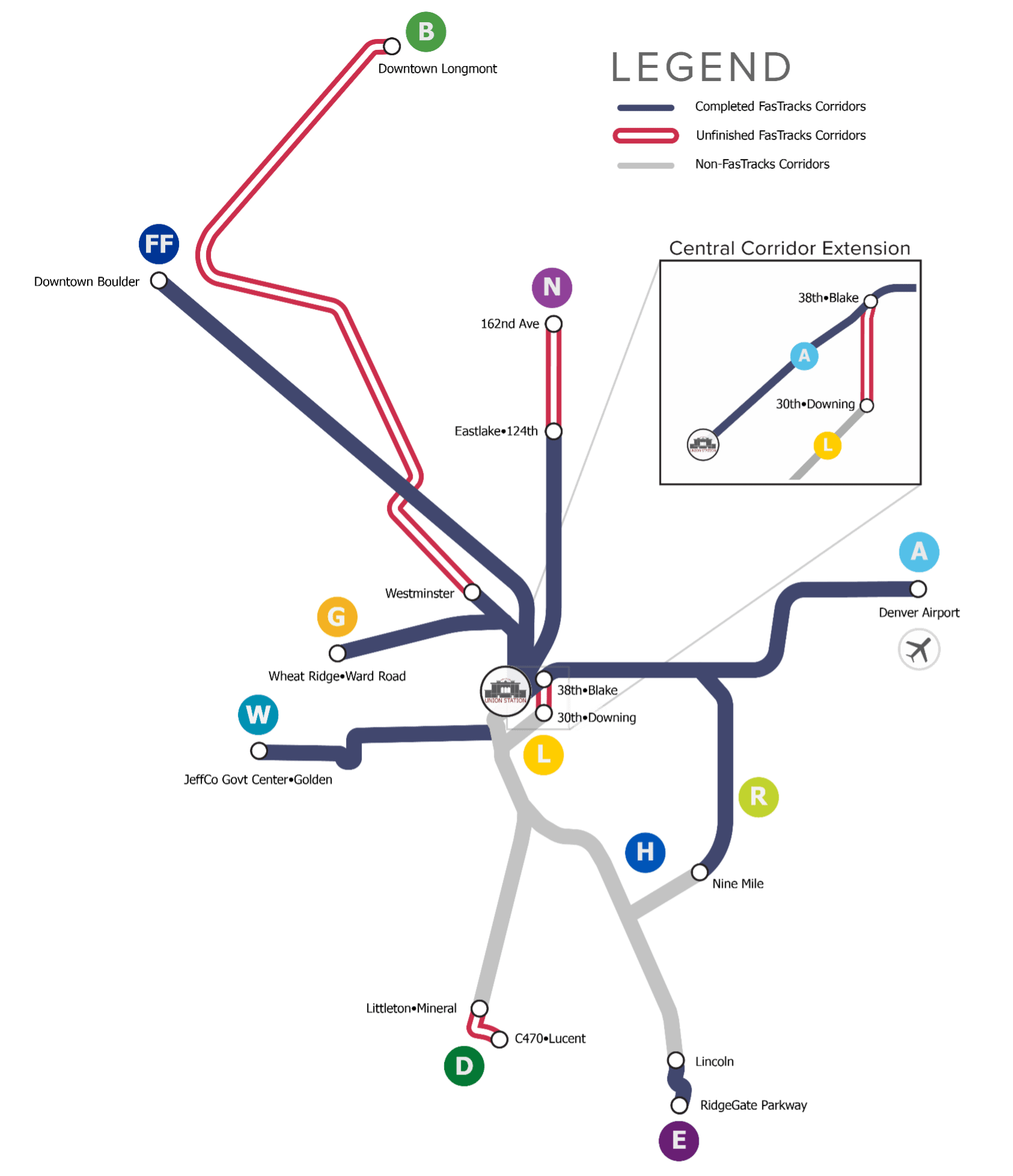
Original FasTracks Budget
The original FasTracks budget was $4.7 billion. To date, RTD has expended significantly more than that amount on the program as illustrated in the table below.
| Project | Spent through 2024 (millions) |
|---|---|
| Central Extension | $ 11.7 |
| Denver Union Station | $ 311.2 |
| Eagle Project (East, Gold, and Northwest to Westminster) | $ 2,362.8 |
| Free MetroRide | $ 12.4 |
| I-225 | $ 655.3 |
| Light Rail Maintenance Facility | $ 17.2 |
| Misc Projects | $ 287.8 |
| North Metro | $ 780.8 |
| Northwest Rail | $ 11.9 |
| Southeast Extension | $ 206.1 |
| Southwest Extension | $ 24.0 |
| US 36 BRT | $ 184.3 |
| West Corridor | $ 678.0 |
| TOTAL | $ 5,543.5 |
Program Challenges and Commodity Cost Changes
Since the passage of FasTracks in 2004, RTD has faced two primary challenges in completing the plan: the 2008 Great Recession’s effect on sales tax collections and construction cost escalation.
The sales tax growth rates used by RTD to project revenue growth in the FasTracks Financial plan were based on two sources. Sales tax growth projections from 2004 through 2009 were based on the Colorado Legislative Council (CLC) forecasts. Sales tax growth rates for the years 2010 through 2025 were provided by AECOM, a global infrastructure consultancy firm, which based their forecasts on data from the Center for Business and Economic Forecasting (CBEF). CLC growth forecasts, while for the entire state, were used in the report because the Denver region constitutes over half the population of the state.
However, the Great Recession severely reduced RTD’s sales and use tax collections. The FasTracks Financial Plan assumed an annual sales tax growth rate of approximately 6.3%. The actual growth rate between 2008 and 2024 was 4.9%.
In March 2020, RTD immediately reduced transit service levels to reflect demand brought on by the COVID-19 pandemic, focusing on routes used by essential workers and transit-dependent populations. Since the pandemic, travel patterns have shifted from a need for peak period commuter service to traditional primary activity centers (such as Downtown Denver, the US 36 Corridor, and the Denver Tech Center), to more crosstown travel, spread somewhat more evenly throughout the day. Downtown Denver, RTD’s primary activity center, has seen dramatic impacts from the pandemic, including a monumental shift to remote work, which has yielded a correspondingly significant decline in transit utilization.
During the same period, worldwide commodity and raw material prices spiked, thereby reducing revenues and increasing construction costs. In 2020, the COVID-19 Pandemic affected the supply chain of materials while at the same time disrupting labor markets, creating a worker shortage, thereby further increasing construction costs. As the following graph illustrates, key commodity pricing trends have increased significantly faster than the FasTracks projections. The graph below illustrates the changes in key commodity costs since the passage of the plan.
In 2024, downtown Denver’s annual visits by employees were at 49% of 2018 levels having dropped from 28.9 million annual visits to 14.9 million (Downtown Area Plan; Community Advisory Committee Presentation; March 6, 2025). While RTD transit utilization is trending up, it is still only 62% of 2020 levels. RTD expects boardings to continue to increase as transit service is added based on resource availability.
Key Commodity Costs and Changes: 2005-2024
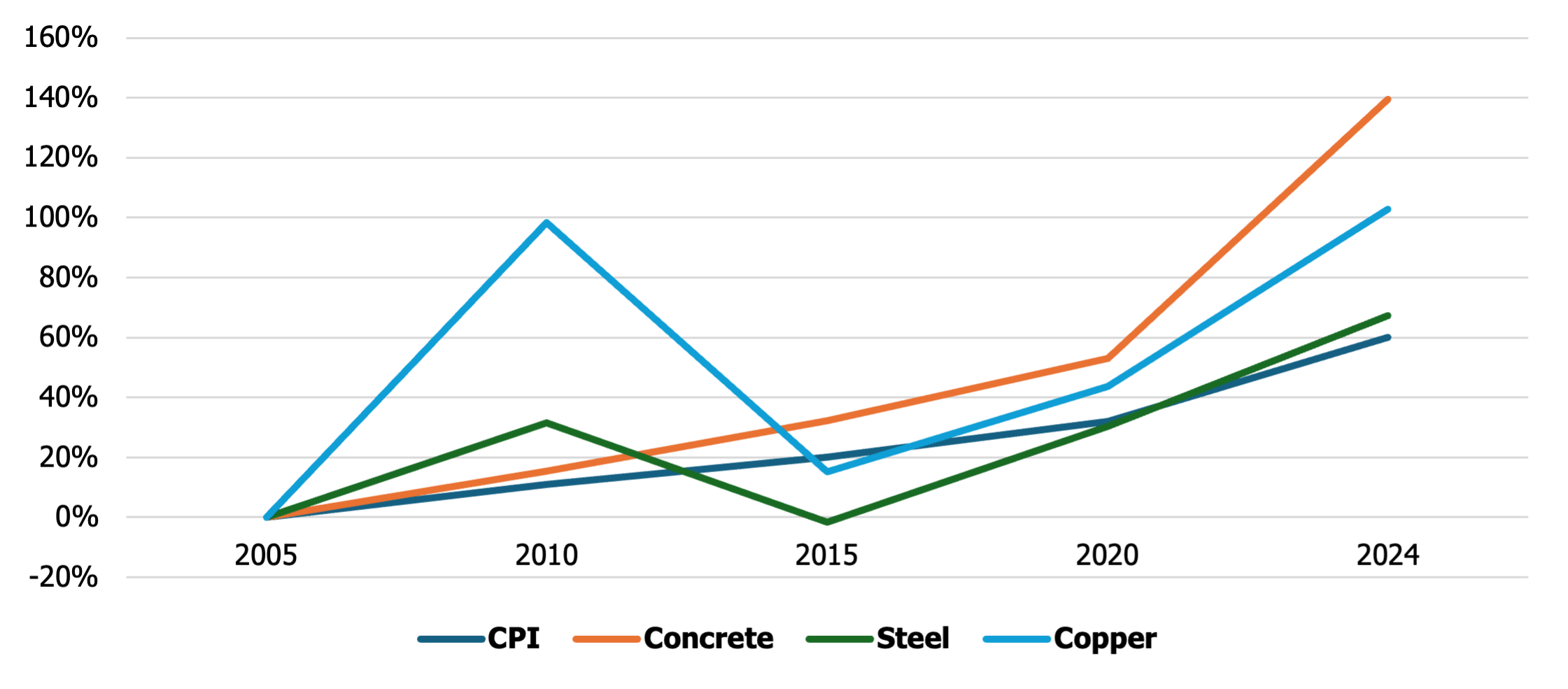
SOURCE: Bureau of Labor Statistics, Producer Price Index
Finishing FasTracks Commitment
RTD Board Resolution
The RTD Board of Directors is committed to completing the FasTracks Plan. On April 16, 2019, the Board approved the Finishing FasTracks Resolution (No. 2019-004), which directed staff to:
- Investigate and research all reasonable cost-saving measures for construction and operation of the unfinished FasTracks corridors, including creative funding mechanisms
- Outline proposed steps to move forward on the unfinished corridors
- Outline proposed steps to move forward on the Northwest Rail Peak Service Plan
- Report back to the Board within 60 days with a draft report
On June 14, 2019, staff provided a draft initial report, titled FasTracks Initial Unfinished Corridors, which represented the beginning of an iterative process with the Board regarding possibilities for the advancement of the unfinished corridors. The report provided potential funding scenarios that would be required to fill the Plan’s funding gap. That report is the foundation upon which this report is structured. Additionally, in 2022 the Board authorized the Northwest Rail Peak Service Feasibility Study to respond to stakeholder input on how RTD might complete the Northwest Rail Corridor by assessing an initial commuter rail service in the corridor. The study, which was completed in summer 2024, examined the peak service concept brought forward by local stakeholders and RTD staff with a specific focus on developing a common set of facts to inform the RTD Board of possible next steps.
Front Range Passenger Rail Collaboration
The Colorado General Assembly created the Front Range Passenger Rail District (FRPRD) in 2021 through Senate Bill 21-238. FRPRD is an independent political subdivision of the State with the mission to plan, design, finance, construct, operate, and maintain a new passenger rail system along the Front Range. FRPRD is governed by a board of directors with 17 voting and seven non-voting members.
The RTD General Manager and Chief Executive Officer is a non-voting member of the FRPRD Board. FRPRD has coordinated closely with the Colorado Department of Transportation (CDOT), RTD, the freight railroads, regional planning organizations, and local Front Range communities. FRPRD’s geographic boundaries extend from the Wyoming border to the New Mexico border, spanning portions or the entirety of the 13 counties near the I-25 corridor along the Front Range. This includes the area in which the Northwest Rail service would operate.
FRPRD is currently in the process of developing a service plan for the passenger rail system based on an Alternatives Analysis (AA) that CDOT and the Southwest Chief and Front Range Passenger Rail Commission (the predecessor to FRPRD) conducted in 2020. The AA recommended a system whereby passenger rail service would operate on shared tracks with freight operations to minimize the initial capital investment needed to implement service. The service proposed for the North Front Range area of the state would operate along Burlington Northern Santa Fe (BNSF) right-of-way from Fort Collins to Denver, overlapping the Northwest Rail Corridor from Longmont to Denver, though it is expected that the FRPRD service would not stop at all the stations associated with the Northwest Rail. This is due to the federal definitions of commuter rail, which is defined as short-haul passenger transportation in metropolitan or suburbanareas, and passenger rail, which refers to longer-distance, intercity corridors. Throughout the Northwest Rail Peak Service Feasibility Study, RTD worked closely with FRPRD and CDOT staffs to identify shared infrastructure and operational opportunities.
Joint Service Agreement
Senate Bill 24-184 (SB-184) authorized RTD, FRPRD, CDOT, and the Colorado Transportation Investment Office (CTIO) to develop an implementation plan for using their respective authorities to deliver, construct, and operate passenger rail service from Denver Union Station to Fort Collins, as the first phase of front range passenger rail service (Joint Service). The goal of Joint Service is to optimize operational efficiencies by combining the resources, expertise, and funding from these agencies to address challenges with the Northwest Rail project, such as rising costs and funding constraints. By working together, the partners aim to deliver a more efficient and cost-effective solution, which includes integrating different types of rail services to meet the region’s transportation needs.
On June 24, 2025, the RTD Board authorized the General Manager and CEO to execute an intergovernmental agreement for the Joint Service Executive Oversight Committee (JSEOC) Intergovernmental Agreement (IGA). The IGA authorizes the agencies to jointly pursue an access agreement with BNSF for passenger rail service from Denver to Fort Collins. On September 9, 2025, during the inaugural meeting of the JSEOC, RTD’s General Manager and CEO was elected as chair of the committee, and the Deputy Executive Director of CDOT was elected as vice chair.
Unfinished Rail Corridors
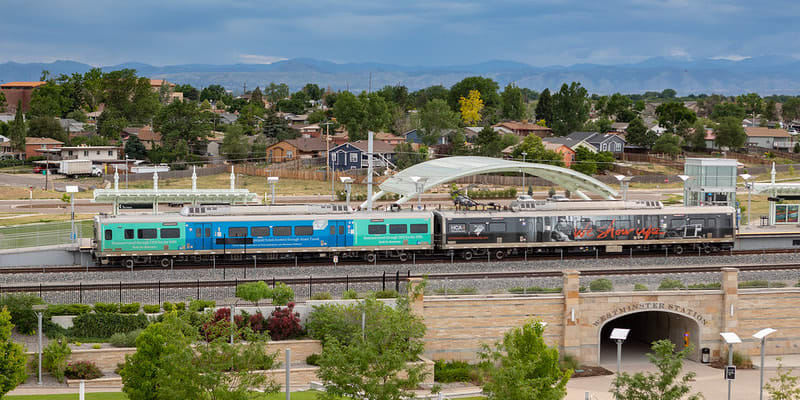 Northwest Rail Peak Service
Northwest Rail Peak Service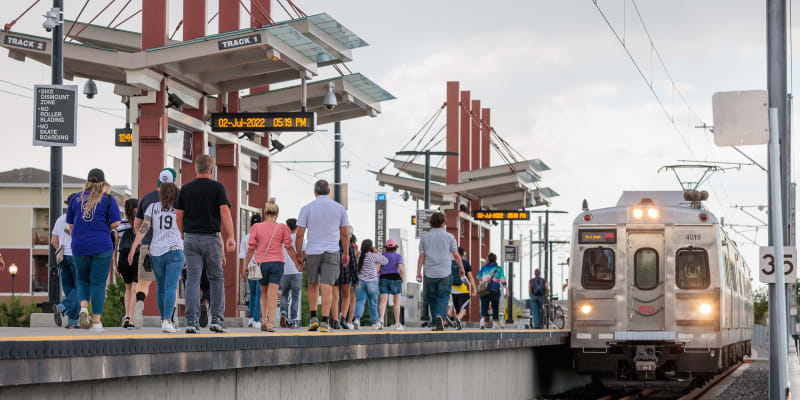 North Metro Corridor
North Metro Corridor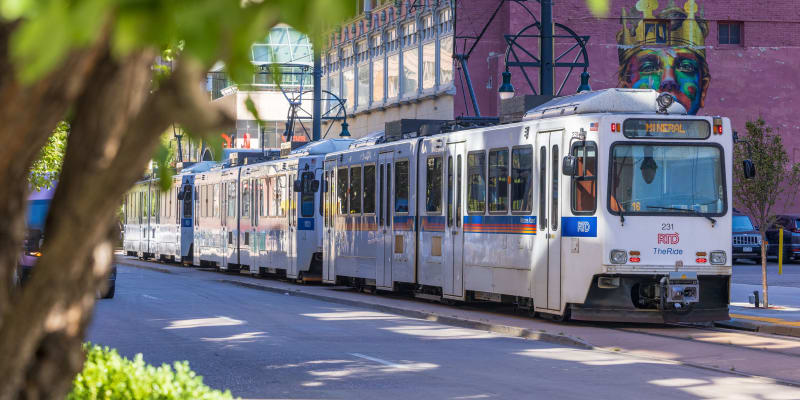 Southwest Corridor Extension
Southwest Corridor Extension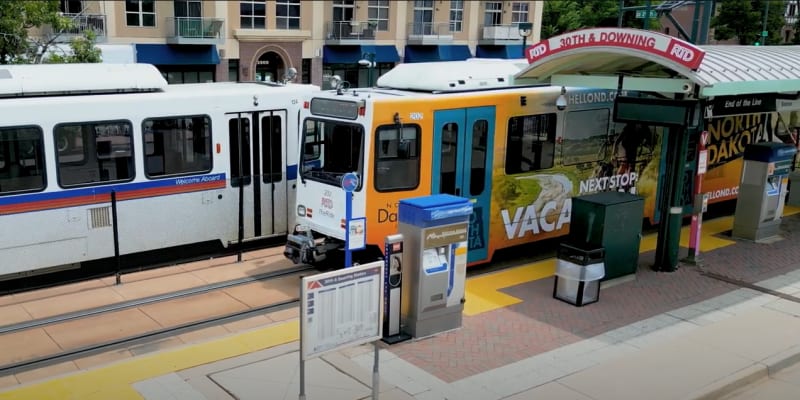 Central Corridor Extension
Central Corridor ExtensionOverview of Unfinished Corridors
RTD has tracked and periodically reported on changing capital and operations cost estimates for the unfinished corridors since voters approved the FasTracks Plan in 2004. In 2024, RTD completed the Northwest Rail Peak Service Feasibility Study, which estimates capital and operating costs for a limited level of commuter service on the corridor. For this report, RTD engaged an external consultant to update costs for the Central Corridor Extension, the Southwest Extension, and the North Metro Completion. These latest estimates build on design and cost estimate work completed in 2010 for the North Metro Completion (30% design), and 2015 for the Central Corridor Extension (15% design) and Southwest Extension (15% design). The estimates use the quantities estimated in 2010 and 2015 multiplied by current unit costs. Forecasted boardings projections were based on outputs from the DRCOG regional travel model. The model considers numerous factors for determining ridership, including future development patterns and the expected transportation network along with growth in population and employment throughout the Denver region.
The updated 2024 corridor capital costs were prepared consistent with Federal Transit Administration (FTA) capital cost estimates for transit capital projects; however, additional costs associated with design changes that may be required to accommodate new development projects along the rights-of-way or regulatory changes related to operational safety are not included. Likewise, assumptions about expanded fleet required to operate each corridor assume an escalation in price over current fleet costs, but existing fleet types are no longer in production. In addition, changes in right-of-way costs were not fully researched due to time limitations in preparing this report and may be undervalued. For each corridor, costs are broken down by the FTA’s Standard Cost Category classification for both 2015 and today.
Capital and Operating Costs for Unfinished Corridors
*in 2024 dollars (millions)
| Corridor | Capital Cost* | Annual Operating Cost | Daily Boardings in Horizon Year (2045) |
|---|---|---|---|
| Northwest Rail Peak Service | $ 649.6 | $ 14.0 | 1,100 |
| North Metro Completion | $ 395.7 | $ 5.4 | 1,500 |
| Southwest Extension | $ 343.5 | $ 2.5 | 700 |
| Central Extension | $ 210.5 | $ 0.7 | 300 |
| TOTAL | $ 1,599.3 | $ 22.6 | 3,600 |

Northwest Rail Peak Service
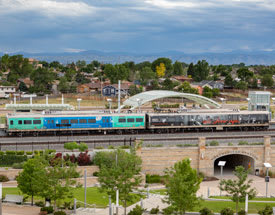
Status
The Northwest Rail is unique among RTD’s commuter rail corridors in that with completion it will not operate in an exclusive right-of-way. RTD obtained ownership of the right-of-way for the existing six-mile B Line from Denver Union Station to Westminster, which operates on a single-track configuration on land purchased from the BNSF Railway. With the corridor’s completion to Longmont, BNSF will continue to operate freight trains on the 39-mile corridor.
Feasibility Study
In 2024, RTD completed the Northwest Rail Peak Service Feasibility Study (Study) to assess the potential for providing limited, commuter rail service in the corridor, a concept brought forward by local stakeholders and RTD staff. The Study is premised on a Peak Service Concept (PSC), as defined by stakeholders and the Board. The PSC provides rail service between Longmont and Denver, serving six new stations and all existing B Line stations. The PSC proposes three trains in the morning from Longmont to Denver Union Station and three trains in the afternoon from Denver Union Station to Longmont.Developing a common set of facts to inform the RTD Board of possible next steps was a specific focus of the Study. Given the recent completion of the Study, substantially more information is available for this corridor than the other corridors discussed in this report.
Unfinished Corridor Map
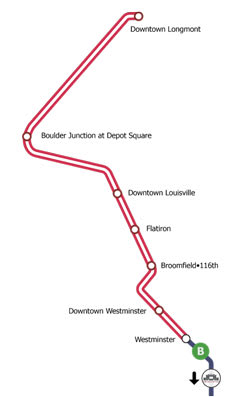
Right-of-Way
The proposed service would use existing freight tracks, which is a unique situation for RTD; however, many commuter rail services throughout the country operate on freight tracks. Another unique aspect to RTD is that this proposal would extend existing passenger rail service on an electrified rail line (the current B Line) to a non-electrified rail line where passenger service is not currently offered. This scenario adds mechanical safety, operational, and regulatory challenges in assessing the feasibility of Northwest Rail passenger service.
Front Range Passenger Rail Coordination
In addition to the public and representatives from local jurisdictions, RTD engaged extensively with two additional stakeholders: BNSF and FRPRD. Working closely with BNSF allowed the Study to address costs and regulatory requirements. CDOT and FRPRD are concurrently developing an intercity rail plan for service between Fort Collins and Pueblo that would share the Northwest Corridor tracks between Denver and Longmont. The Northwest Rail Peak Service Feasibility Study focused on the Peak Service Concept, while the intercity rail plan has other objectives for a more intercity-type service.
The intercity rail would have five stations between Longmont and Denver, whereas the Northwest Rail Corridor has six stations. As noted, the RTD service would provide three one-way trains Denver-bound in the morning and three one-way trains Longmont-bound in the afternoon.
Joint Service Agreement
Senate Bill 24-184 (SB-184) authorized RTD, the Front Range Passenger Rail District (FRPRD), CDOT, and the Colorado Transportation Investment Office (CTIO) to develop an implementation plan for using their respective authorities to deliver, construct, and operate passenger rail service from Denver Union Station to Fort Collins, as the first phase of front range passenger rail service (Joint Service). The goal of Joint Service is to combine the resources, expertise, and funding from these agencies to address past challenges with the Northwest Rail project, such as rising costs and funding shortages. By working together, the partners aim to deliver a more efficient and cost-effective solution, which includes integrating different types of rail services to meet the region’s transportation needs.
On June 24, 2025, the RTD Board authorized the General Manager and CEO to execute an intergovernmental agreement for the Joint Service Executive Committee Oversight Intergovernmental Agreement (IGA). The IGA authorizes the agencies to jointly pursue an access agreement with BNSF for passenger rail service from Denver to Fort Collins.
Design and Environmental Review
The Northwest Rail Peak Service Feasibility Study built upon and updated the review of environmental resources previously documented in the 2010 Northwest Rail Corridor Final Environmental Evaluation. The reviewed resources were those that are most often included in National Environmental Policy Act (NEPA) compliance and documentation. RTD contracted with BNSF to complete 30% track design and an external consultant to complete 10% station design to serve as the cost basis for Northwest Rail peak service.
Other Considerations
As noted, this proposal would extend existing passenger service on an electrified rail line (B Line) to a non-electrified rail line where passenger service is not currently offered. Rail sidings would be constructed for the freight trains to allow travel for the passenger trains. A new commuter rail maintenance and storage facility would be required near the northern end of the line. Additionally, a layover yard for storage and light maintenance of trains during the midday period would be required when the trains are not in service. RTD and FRPRD have had high-level discussions regarding the potential for a shared maintenance facility.
Cost Comparisons
Northwest Rail Peak Service
A comparison of costs between 2015 and 2024. The peak service concept was not fully analyzed prior to the completion of the Northwest Rail Peak Service Feasibility Study.
| Cost Group | 2024 (millions) | 2015 (millions) | Change (%) |
|---|---|---|---|
| Guideway, Track, Stations, and Parking | $ 312.0 | N/A | --- |
| Fleet Maintenance and Storage Facilities | $ 87.8 | N/A | --- |
| Vehicles | $ 136.5 | N/A | --- |
| Professional Services | $ 97.5 | N/A | --- |
| Local Agency Participation (2.5%) | $ 15.8 | N/A | --- |
| TOTAL | $ 649.6 | N/A | --- |

North Metro Corridor
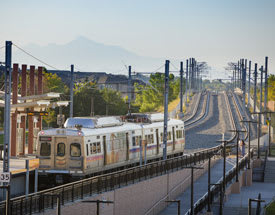
Status
The full North Metro corridor is an 18-mile line from Denver Union Station to SH 7/162nd Avenue in Thornton. Most of the completed corridor is a single-track configuration with passing locations in five areas.
The initial operating line, from Denver Union Station to 124th•Eastlake, began revenue service in September 2020. The corridor trains are serviced at the Commuter Rail Maintenance Facility (CRMF) at 48th Ave and Fox Street, which also services the B Line (Northwest Rail Initial Segment), the G Line (Gold Line) and the A Line (East Corridor) trains. Denver Transit Partners maintains the vehicles, and RTD is responsible for operations, right-of-way maintenance and associated operational functions for the corridor.
Unfinished Corridor Map
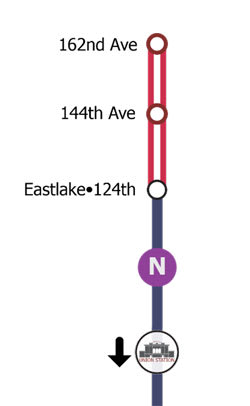
Right-of-Way
The N Line operates in the Union Pacific (UP) Boulder Branch right-of-way, which RTD purchased from UP in 2006. As noted above, the first phase of the current N Line service terminates at the 124th•Eastlake Station in Thornton. The remainder of the corridor would continue to operate within the RTD-owned UP Boulder Branch right-of-way with additional stations at 144th and State Highway 7 (CO 7)/162nd. While no additional right-of-way acquisitions would be needed for the track alignment, additional right-of-way acquisitions would be required to accommodate the two new stations and Park-n-Rides.
Design and Environmental Review
Design work for this future segment has been completed up to the 30% level. Moving this project forward will require final design and additional environmental review.
Other Considerations
RTD staff has met with City of Thornton and Adams County staff to discuss relevant changes that could affect the corridor completion. Staff members noted new multi-family developments planned or under construction in the 144th Ave. Station area – one of which could impact right-of-way needed station parking. For the 162nd Ave. Station, staff members noted that the area has been zoned for transit- oriented development and discussed the potential synergy between this station and the adjacent future CO 7 BRT station. Also, there may be opportunities to partner with CDOT and the local communities to address drainage issues in the CO 7 general area.
Cost Comparisons
North Metro Corridor
A comparison of costs between 2015 and 2024.
| Cost Group | 2024 (millions) | 2015 (millions) | Change (%) |
|---|---|---|---|
| Guideway, Track, Stations, and Parking | $ 268.9 | $ 139.8 | 92% |
| Fleet Maintenance and Storage Facilities | $ 0.9 | $ 0.6 | 50% |
| Vehicles | $ 54.2 | $ 36.3 | 49% |
| Professional Services | $ 62.7 | $ 45.1 | 39% |
| Local Agency Participation (2.5%) | $ 9.0 | $ 5.5 | 64% |
| TOTAL | $ 395.7 | $ 227.3 | 74% |

Southwest Corridor Extension
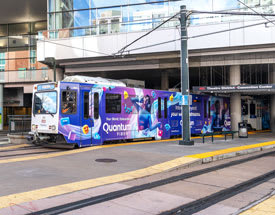
Status
The Southwest Extension is a 2.5-mile double-track light rail project that would extend the D Line from the Littleton•Mineral Station to a new station in Highlands Ranch with a 1,000-space Park-n-Ride.
The additional station will be located near the intersection of C-470 and Kendrick Castillo Way (formerly Lucent Blvd).
Unfinished Corridor Map
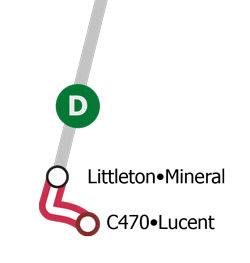
Right-of-Way
RTD completed an Environmental Evaluation (EE) for the Southwest Extension in March 2010. The EE assumed that RTD would use the Consolidated Main Line (CML) right-of-way to extend the corridor from its current terminus at Mineral Ave. to C-470. RTD has a 2007 agreement with CDOT allowing for the use of C-470 right-of-way from the CML to the corridor’s end-of-line station at Kendrick Castillo Way. RTD acquired the property for the end-of-line station and Park-n-Ride in 2008.
Design and Environmental Review
The RTD Board adopted the mitigation measures from the EE in March 2010. Environmental review is largely complete for the project, and engineering design reached approximately 30%.
Since the completion of the EE in 2010, CDOT has constructed a flyover at the intersection of Santa Fe Drive (US 85) and C-470. It is unclear whether the flyover configuration would affect the 2010 design developed for the EE. Further study would be needed to determine any impacts to the corridor’s assumed design.
Other Considerations
RTD staff has met with City of Littleton, Arapahoe and Douglas county staffs to discuss relevant changes that could affect the corridor completion. Primary changes identified were new developments in the existing Littleton•Mineral Station area and the completion of the C-470/Santa Fe interchange.
Cost Comparisons
Southwest Extension
A comparison of costs between 2015 and 2024.
| Cost Group | 2024 (millions) | 2015 (millions) | Change (%) |
|---|---|---|---|
| Guideway, Track, Stations, and Parking | $ 241.3 | $ 139.1 | 73% |
| Fleet Maintenance and Storage Facilities | $ 0 | $ 0 | 0% |
| Vehicles | $ 29.2 | $ 19.6 | 49% |
| Professional Services | $ 64.6 | $ 36.5 | 77% |
| Local Agency Participation (2.5%) | $ 8.4 | $ 4.9 | 71% |
| TOTAL | $ 343.5 | $ 200.1 | 72% |

Central Corridor Extension
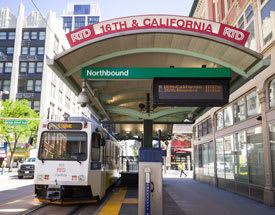
Status
The design concept for the Central Corridor Extension, as currently proposed, consists of an in-street running LRT connecting the existing L Line light rail service at 30th•Downing Station with the 38th•Blake Station on the A Line (approximately 0.8 miles). Two new stations would be constructed at 33rd•Downing and 35th•Downing.
Unfinished Corridor Map
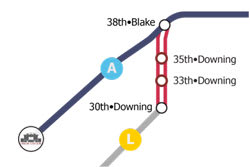
Design and Environmental Review
RTD completed a detailed mobility study for the project in 2014, examining several alignment and operational options for the extension.
Operational Considerations
The 2014 study found that the extension, as currently proposed, with in-street LRT sharing the travelway with vehicular traffic, would not operate reliably. In fact, staff was unable to write a schedule for the proposed service due to significantly variable travel times between 30th•Downing and 38th•Blake. Additional study would be required to determine the final alignment and a functional operating plan before moving this project forward.
Other Considerations
RTD staff has met with City and County of Denver (City) staff to discuss relevant changes that could affect the corridor completion. Staff noted the extensive new development on the north end of the corridor, which could further impact operations. Staff indicated that the City as well as residents and the area business community still strongly support having a transit connection between the Central Corridor’s 30th•Downing Station terminus and the A Line 38th•Blake Station.
Denver’s Mayor Mike Johnston sent a letter, dated April 11, 2025, to RTD General Manager and CEO Debra A. Johnson requesting that RTD delay the portion of the Downtown Rail Replacement Project (DRRP) to allow stakeholders an opportunity to “discuss and evaluate options that help meet community, economic, and mobility needs, while also fulfilling FasTracks commitments.”
Cost Comparisons
Central Corridor Extension
A comparison of costs between 2015 and 2024.
| Cost Group | 2024 (millions) | 2015 (millions) | Change (%) |
|---|---|---|---|
| Guideway, Track, Stations, and Parking | $ 150.9 | $ 81.0 | 86% |
| Fleet Maintenance and Storage Facilities | $ 0 | $ 0 | 0% |
| Vehicles | $ 12.5 | $ 8.4 | 49% |
| Professional Services | $ 42.0 | $ 19.3 | 118% |
| Local Agency Participation (2.5%) | $ 5.1 | $ 2.7 | 89% |
| TOTAL | $ 210.5 | $ 111.4 | 89% |

Other Unfinished FasTracks Projects
US 36 Remaining Commitments
The 2004 voter-approved FasTracks Plan provided $204.1 million for BRT in the US 36 Corridor. The original budget assumed RTD would contribute an additional $66 million for the RTD contribution to the high-occupancy vehicle/bus lanes (this was prior to the decision to pursue managed lanes) along with various upgrades to the corridor’s stations. The remainder of the scope was left undefined. RTD did not define a specific scope for the corridor for the following reasons:
- The joint CDOT/RTD Environmental Impact Statement (EIS) was not completed when the FasTracks Plan was under development
- It was unknown at the time of the FasTracks Plan development how BRT would integrate with CDOT expansion of the highway
- It was assumed that construction would likely be led by CDOT since many of the anticipated BRT elements would share the CDOT facility
Through the 2013 Northwest Area Mobility Study (NAMS) process, RTD worked with stakeholders to determine the remaining capital elements that should be included in the scope. The RTD Board approved the final scope elements on August 28, 2013. RTD has completed a majority of the NAMS scope items; however, several items have not been completed. They are as follows:
- Relocation of the Church Ranch Station boarding platforms closer to RTD-designated parking
- Improvements for vertical circulation (additional stairs and elevators) on each side of the bridge at US 36/Sheridan Station
- Construct a Park-n-Ride with structured parking on the north (east) side of US 36 at the Broomfield Station for better access to the station for residents north and east of US 36 in Broomfield
| Corridor | Capital Costs (millions) | Annual Operations Costs (millions) | Daily Boardings in Horizon Year (2045) |
|---|---|---|---|
| Northwest Peak Service | $ 649.6 | $ 14.0 | 1,100 |
| North Metro Completion | $ 395.7 | $ 5.4 | 1,500 |
| Southwest Corridor Extension | $ 343.5 | $ 2.5 | 700 |
| Central Corridor Extension | $ 210.5 | $ 0.7 | 300 |
| Total | $ 1,599.3 | $ 22.6 | 3,600 |
FastConnects: Increased Bus Service
The FasTracks Plan included not only the construction of rail and bus rapid transit corridors but also increased bus service and increased parking. Specifically, regarding the use of the sales and use tax increase and the bond proceeds, the ballot language states: “…to be used and spent for the construction and operation of a fixed guide way mass transit system, the construction of additional park-n-ride lots, the expansion and improvement of existing park-n-ride lots, and increased bus service.”
To implement the increased bus service component, the adopted FasTracks Plan included “Bus Feeder Service to Rapid Transit” and “Suburb to Suburb Service.” Funding for these Base System service increases was included in the 2004 FasTracks financial plan. Consistent with that financial plan, in January 2006, RTD began a financial contribution from FasTracks to the Base System bus services equivalent to 1% of total bus service hours each year through 2020 and 1.5% per year from 2021 through 2025. The 2004 Plan indicated that “by 2025, RTD will provide an additional 700,000 hours of bus service annually.”
Corridor Costs and Funding Strategies
Fiscal Capacity
RTD annually prepares updated Five-Year Financial Forecasts (FYFF) and periodically prepares long-range financial forecasts for the Base System and FasTracks. These comprehensive forecasts utilize the latest cost information for ongoing operations and maintenance, capital requirements, state-of-good-repair funding needs, and all known related costs needed to maintain service and keep the transit system operational while meeting the Board’s priorities. The forecasts utilize updated projections regarding revenue sources, including sales and use tax, farebox, and other sources. The sales and use tax revenue forecasts use the latest information provided by the University of Colorado Leeds School of Business.
Additionally, other key capital, operations, and maintenance costs illustrated herein are estimates and subject to change. Similar to the analysis performed in the 2019 Unfinished Corridors Report, RTD’s proposed FYFF for 2026-2030 shows no capacity for any major capital expenditures beyond necessary state-of-good-repair activities. Further, RTD has other constraints limiting its ability to raise revenue as discussed herein.
Borrowing Capacity
The 1992 voter-approved Taxpayer Bill of Rights (TABOR) amendment to the Colorado State Constitution established a requirement that all Colorado governments must receive voter approval to increase taxes or issue new debt. The TABOR requirement for voter approval applies to the issuance of bonds, which, in RTD’s case, are issued with a pledge of repayment from future sales and use taxes collected. The 2004 voter-approved FasTracks initiative authorized RTD to collect an additional 0.4% sales and use tax and authorized RTD to issue a fixed amount of bond debt to implement the FasTracks Plan. When the FasTracks debt fully matures in 2050, the sales and use tax rate will decrease to the amount necessary for the continued operation of the system but not less than 0.6%.
The 2004 ballot language fixed the amount of bond debt at $3.477 billion of principal and $7.129 billion of total debt repayment (principal plus interest). The maximum annual debt service was capped at $309.7 million. It should be emphasized that virtually all debt authorization for both the Base System and FasTracks has now been exhausted, leaving no additional bond borrowing capacity for RTD without voter approval. Based on RTD’s current debt obligations, RTD’s remaining voter-authorized debt issuance authority is limited to an additional $1.34 million with a total repayment (principal and interest) limit of $2.47 million.
RTD can issue Certificates of Participation (COPs), which are a form of a lease-purchase agreement requiring annual debt service appropriation by the Board. While COPs are not subject to TABOR limitations, the underlying asset being financed must be essential to RTD's operations and free of any encumbrances, such as federal funding. While COPs provide a potential source of funding, this financing mechanism incurs additional costs due to interest expense. Furthermore, the 2026-2030 FYFF has not identified sufficient cash flow available for debt service if new borrowings for incremental service were to be considered.
FasTracks Internal Savings Account (FISA)
In 2012, the Board created the FasTracks Internal Savings Account (FISA) with the intent to establish a savings account for the unfinished corridors in part by capping future enhanced bus service to 2013 levels plus inflation using the Consumer Price Index (CPI) for the Denver-Lakewood-Aurora area. The voter-approved FasTracks Plan does not permit FasTracks funds to be used for Base System expenditures, except for paying for fixed-route bus or ADA service (“rubber tire” service) that would be necessary to support the FasTracks buildout, including both new rail and new Flatiron Flyer bus service on the US-36 BRT corridor.
The FasTracks financing plan assumed annual growth in bus service within RTD service area. Between 2006 and 2013, prior to the FISA action, RTD contributed $73.5 million in FasTracks sales and use tax revenue to rubber tire service supporting the FasTracks buildout. However, by approximately 2013, it became apparent that revenue service hours were not in fact growing at the anticipated rate, and the Board opted to cap the revenue hour growth and divert funding into the FISA. This change created a reduction in the annual amount planned to be paid from FasTracks to the Base System with the excess being recorded in the FISA. The current FISA balance is approximately $192 million, and the current balance may change based on the proposed 2026-2030 FYFF.
It was estimated that between 2014 and 2025, $342.3 million in total would have been available for enhanced bus service without the FISA action. The $342 million equates to approximately 1 million revenue service hours. For comparison, this is not quite half of the 2025 total service hours.
Denver Transit Partners Debt
The Northwest Line (B Line) to Westminster along with the East (A Line) and Gold (G Line) lines were completed through a Public-Private Partnership (P3) agreement with Denver Transit Partners (DTP). To raise the necessary funding for construction, DTP issued $398 million in Private Activity Bonds (PABs), and RTD agreed in its CA with DTP that the monthly payment DTP receives would include two parts: a TABOR portion, which is a fixed monthly payment for DTP to pay debt service on the PABs, and a monthly service payment for providing operations and maintenance, which can change with Memorandums of Relief (MORs) for changes in service and also has CPI factors applied each year.
The debt service portion is sometimes referred to as the TABOR portion of the service payment, because it is a multi-year obligation for RTD that falls under TABOR in that it used some of the FasTracks voter-authorized debt limits. It is classified as an Other Long-Term Liability on RTD’s balance sheet.
RTD Reserve Funds
Although RTD’s proposed 2026-2030 FYFF shows that RTD projects to end 2030 with an estimated $795 million in available reserves, most of these reserves are encumbered for specific items not captured within the FYFF horizon. RTD has several types of reserve funds, including:
- The Capital Replacement Fund is expected to be fully utilized by 2031.
- The Operating Reserve reflects three months of operating expense (anticipated to be $266M in 2030), is required per the Board-approved fiscal policy to establish an operating stabilization reserve to ensure services can be delivered during unforeseen circumstances, particularly due to the volatility of sales and use tax collections comprising more than 70% of RTD’s revenue sources.
- The Unrestricted Reserve, is planned to be largely depleted by 2030 for repayment of agency debt and for expanding service as outlined in the current the System Optimization Plan, which identifies service enhancements through 2027.
Potential Sources of Additional Revenue
SB-230: Oil and Gas Production Fees
In addition to requiring RTD to prioritize the completion of the Northwest Rail and North Metro corridors, SB-230 imposes new oil and gas production fees to be used to expand transit service, frequency, ridership, and fund passenger rail projects. The Colorado Energy Office (CEO) Clean Transit Enterprise will disburse the funds into the following three categories:
- Local Transit Operations Formula Program (70%)
- Rail Funding Program for passenger rail projects (20%)
- Local Transit Competitive Grant Program (10%)
The Clean Transit Enterprise funds are estimated to reach approximately $116.3 million by fiscal year 2026-2027, with that amount decreasing to approximately $90 million per year in FY 2028 through FY 2030. RTD recognizes that there will be competing statewide needs for this funding and understands that revenue amounts may vary depending on production. RTD expects to benefit greatly from these programs to sustain and expand operations of the existing system. However, only the 20% Rail Funding Program ($18 million per year after 2028) presents a clear alignment with the Northwest Rail and North Metro corridors, and only a portion of that program will be available to RTD.
- Average annual revenue (2026 to 2034): $90 million
- Potential amount available to FasTracks: a subset of
the Rail Funding Program, which is expected to be approximately $18 million per year.
SB-184: Support Surface Transportation Infrastructure Development
SB-184 authorizes the Colorado Transportation Investment Office (CTIO) to impose a congestion impact fee on short-term vehicle rentals at up to $3.00 per day. CTIO would allocate funding for statewide multimodal transportation options, including rail projects. Legislative economists estimated that approximately $58 million in new revenues will be collected by fiscal year 2025-2026, increasing to $80 million by 2035-2036. Similar to SB-230, these funds can be used for projects statewide, with an even broader range of eligible multimodal projects. The program has not yet established a mechanism for distributing funds. RTD will continue to monitor the status of the program and will engage with CTIO on potential allocations if and when the funds become available.
- Average annual revenue (2026 to 2034): $70 million
- Potential amount available to FasTracks: Unknown, but broad eligibility limits potential allocation.
Federal Funding: Capital Investment Grants Program
The New Starts program is a nationwide, competitive grant program intended to help fund fixed guideway (rail and bus) transit projects.
The New Starts program is a rigorous, multi-step, multi-year process of project development and review intended to assure the strongest transit projects nationally are selected for federal funding. The FTA uses a variety of project justification and financial readiness measures to rank candidate projects against minimum criteria and tracks the progress of projects annually through their program toward the award of a Full Funding Grant Agreement. Over the past decade, the FTA has provided most successful projects nationally with roughly 50% of the total project cost through the New Starts grant program.
RTD’s 2004 Plan assumed that three corridors, the East, West, and Gold rail lines, would seek New Starts funding from the FTA. This assumption was based on the assessment at the time that these corridors were the strongest in terms of project justification when measured against the FTA’s then-current criteria.
The 2004 FasTracks Financial Plan projected that RTD would be successful in obtaining FTA discretionary New Starts grant funding totaling $815 million. RTD was successful in the pursuit of Full Funding Grant Agreements for each of those three targeted corridors, ultimately receiving more federal funding than expected in the FasTracks Financial Plan. In 2009, the FTA awarded $309 million for the West Corridor (44% of project cost), and in 2011 the FTA awarded $1.03 billion for the East and Gold rail lines in a combined Full Funding Grant Agreement for the Eagle P3 project (52% of project cost for the “federalized” portion of the project).
Additionally, in 2012/2013 RTD applied to the FTA for funding for the Southeast Rail Extension under the Capital Investment Grants program after determining the potential eligibility of this project under the FTA’s updated rules and criteria. In 2016, RTD successfully completed the multi-year process with the FTA and was awarded a Small Starts Construction Grant for the Southeast Rail Extension for $92 million (43% of project cost). The FTA’s Small Starts grant program is similar to the New Starts program but is intended to assist with funding projects that fall below certain total cost ($300 million) and federal share ($100 million) thresholds and intended to streamline the process.
In total, through 2018, the FTA has awarded RTD more than $1.4 billion in funding through these grants, exceeding the original 2004 plan of $815 million by approximately $615 million. RTD has continued to explore viability of the Capital Investment Grants (CIG) program (New Starts, Small Starts, and Core Capacity) for FasTracks projects that are not yet under construction. Nationally, the program is more oversubscribed than it has ever been, with over $38 billion required to fund projects that have already qualified for the CIG program.
For this report, RTD analyzed the likelihood that the four remaining guideway components—Central Rail Extension, North Metro Completion, Northwest Rail Line, and Southwest Rail Extension—would qualify for the CIG program based on current criteria. Assuming a 2034 target date for submittal of these projects, staff completed all necessary calculations to determine the rating each project would likely receive and determined that none would likely qualify for CIG funding.
SB 2021-260
The State Legislature created the Multimodal Transportation and Mitigation Options Fund (MMOF) in 2018. The legislation provided a one-time allocation of state funding for the program. Senate Bill 2021-160 expanded the goals of the program and dedicated a significant portion of the State’s American Rescue Plan Act (ARPA) funds in addition to generating annual state revenues for the program. MMOF provides funding for various transportation projects, including bicycle, pedestrian, and transit initiatives, as well as Greenhouse Gas reduction efforts. The MMOF is funded by state dollars primarily from the state’s retail delivery fee revenues and General Fund transfers. Eligible projects range from capital construction and operating costs for transit to transportation demand management programs and multimodal mobility projects.
In the Denver region the funds are awarded through DRCOG. The grant awards require a 50% local match. Currently, all MMOF dollars for the Denver region are programmed through fiscal year 2029. For the period 2030 through 2032 – when the program is expected to end – DRCOG has estimated that approximately $30 million total will be available for the region. In an optimistic scenario, RTD could be awarded approximately one-third of that funding amounting to $10 million for the unfinished corridors. RTD will continue to monitor future Transportation Improvement Program (TIP) cycles to pursue this funding source.
Other Federal, State and Local Government Programs
In addition to the large-scale Capital Investment Grants (CIG) program, RTD has an extensive history of pursuing a wide variety of other federal, state, and local grant opportunities to support its capital projects and operating needs. Since 2009, RTD has submitted 198 applications to numerous grant programs, requesting approximately $1.37 billion in total funding. Of these requests, 70 applications were successful, resulting in the award of over $218 million. These awards have come from a diverse array of funding partners, including FTA, CDOT, and DRCOG.
This grant history demonstrates RTD’s institutional capacity and experience in navigating complex and competitive funding processes. However, it also contextualizes the scale of the funding challenge for the remaining FasTracks corridors. While these grant programs are a vital component of a comprehensive financial strategy, they are unlikely to provide the magnitude of funding necessary to close the entire financial gap for completing the system. Therefore, these opportunities represent an important but supplementary funding source that must be leveraged alongside other, more substantial financial mechanisms.
Funding Challenges
Completing the remaining FasTracks corridors requires $1.6 billion for construction. As the table shows, RTD has identified only $441 million in potential funding for the period from 2026 to 2034, leaving a significant gap of more than $1.1 billion.
However, the financial challenge is even greater than these numbers suggest:
- The $1.6 billion construction cost is in 2024 dollars and does not account for future inflation. The actual cost to build the corridors will be much higher.
- The $441 million in available funding is an optimistic estimate. It assumes a larger share of statewide funds will be allocated to FasTracks than is likely.
Even if the project were scaled back to only complete the Northwest Rail Peak Service and the North Metro corridor, the total construction cost would be approximately $1 billion. This reduced cost still far exceeds the $441 million in projected funding.
Furthermore, all these figures reflect capital construction costs only. They do not include the additional millions of dollars that would be required over this period to operate and maintain the new services once they are built.
Summary
While RTD has completed a substantial portion of the FasTracks program, outstanding commitments remain. An examination of RTD’s financial condition indicates that unless a new funding source can be identified, between now and 2034, RTD expects to have only FISA funds available for new construction which would not be enough to cover any of the remaining corridors.
Next Steps and Opportunities
RTD’s proposed 2026-2030 FYFF shows that RTD does not have significant available reserves in the 2026-2030 timeframe, and capital reserves will be needed to fund significant expenditures in the early 2030s for large-scale vehicle procurements, i.e., light rail vehicle replacements in 2032 totaling $800 million to $1 billion; bus replacements totaling $234 million; and ongoing light rail reconstruction efforts estimated at $250 million. Also, RTD’s Unrestricted Reserve is planned to be depleted by 2030 for repayment of agency debt and for state of good repair efforts.
Funding from the SB-260, SB-230, and SB-184 programs could potentially contribute toward limited plan completion. RTD recognizes that funding for these programs may be variable and that the funds are intended to be allocated statewide, in which case RTD would be required to compete for these funds against other state needs. Also, RTD Board action would be required to authorize the release of the FISA funds and the construction of any of the corridors would require SB-208 review by DRCOG.
Should funding become available for construction, time would be needed to complete the final planning and required environmental review for each corridor along with a minimum of one year needed to complete final design. Depending on the corridor, construction of each corridor would likely span two to three years. Construction of multiple corridors simultaneously will present challenges with labor and construction materials availability. Should there be challenges with any of the stages of project development or if there were a significant economic downturn, the timeframe for full Plan completion could be extended beyond 2034.
Depending on the funding secured for capital investments, RTD will also need funding for the operations and maintenance of the corridors. As the table below illustrates, annual operating costs and capital replacement require a significant stream of ongoing funding.
The cost estimates provided in this report are a snapshot of current costs. Commodity and labor costs have been extremely volatile over the last several years, and costs associated with the corridor buildouts will change as higher levels of design are completed. Also, depending on actions at the federal level, such as the imposition of new tariffs, the costs of certain materials may rise further, thereby raising construction costs beyond current estimates.
RTD recognizes that this report is a first step in moving forward with completing the FasTracks plan, and the agency looks forward to working with the Governor’s office, the Colorado General Assembly and other stakeholders to continue the discussion of sustainable expansion of effective transit in the region.
FasTracks Feedback Form
Customers, stakeholders, and members of the community are invited to use this form to ask questions and share their feedback related to the draft 2025 Finishing FasTracks Report. All submissions will be collected and included in the final report that is submitted to the Colorado General Assembly.